PREVIOUS: JAPAN-KAMAKURA
JAPAN 1890 - 1904
LAFCADIO HEARN IN MATSUE 1890 - 1891
To find the various places connected with Hearn, download the Google Earth program from the internet and then install the
GE Lafcadio Hearn Post
Honoring a Westerner in Japan,
New York Times, 20 February 2007

As snow silently fell on the miniature garden outside, Bon Koizumi sat on the same tatami mat floor where, more than a century before, his great-grandfather wrote down some of Japanís best-loved folk tales.

Bon Koizumi, Lafcadio's grandson
Mr. Hearnís descriptions of this medieval city and its ancient tales of gods and ghosts put Matsue on the map in the 1890s. Even now it is a popular tourist destination, thanks to Japanís enduring fascination with Mr. Hearn, who married a local samuraiís daughter, took Japanese citizenship and died in Tokyo in 1904.
In the United States there was Alexis de Tocqueville, a French aristocrat whose descriptions of fledgling American democracy in the early 19th century still resonate today.
For many Japanese, Mr. Hearnís appeal lies in the glimpses he offered of an older, more mystical Japan lost during the countryís hectic plunge into Western-style industrialization and nation building. His books are treasured here as a trove of legends and folk tales that otherwise might have vanished because no Japanese had bothered to record them.
Matsue appears so often in Mr. Hearnís books that most Japanese naturally associate him with the city, even though he cut short his stay here to escape the bitter winters. He spent most of his 14 years in Japan in another provincial city, Kumamoto, and in Tokyo before his death at 54. The 300-member Hearn Society of Matsue invites scholars for conferences and promotes the Hearn legacy with Irish cooking festivals, classes in Gaelic and, this year, its first St. Patrickís Day parade....
Martin Fackler, NY-Times, 2007
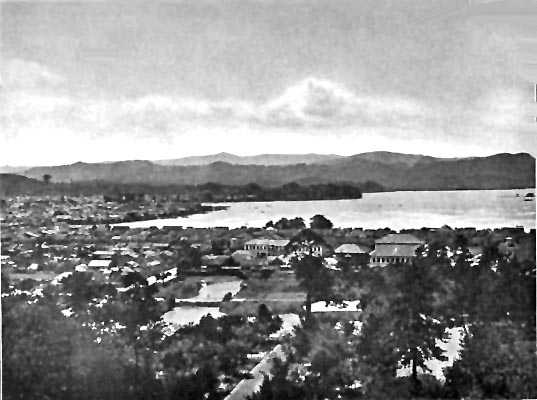
The town of Matsue, 1890
The 15 months Hearn spent in the quaint old city of Matsue
was one of the happiest and intellectually most productive of Hearn's life.
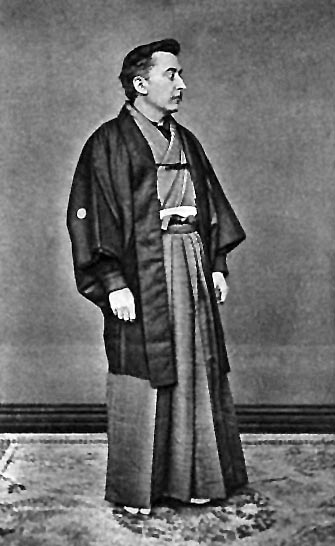
Lafcadio Hearn in a kimono, 1890
Through a fellow teacher at Matsue Middle School a marriage with Setsu Koizumi, the daughter of a local samurai family, was formally arranged.
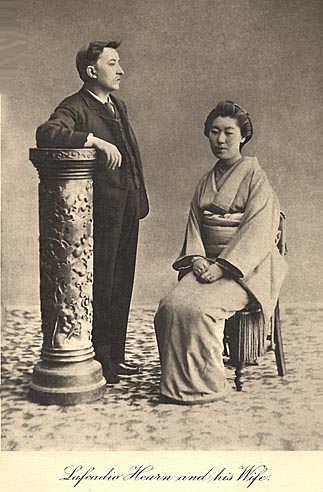
Hearn and his wife 1891. He adopted her family name: Kazuo Koizumi. When he was made professor at Imperial Tokyo University in 1896 he became a Japanese citizen.
Photos from The Life and Letters of Lacadio Hearn, by Elizabeth Bisland, Houghton, Mifflin, Boston, 1906
Matsue - Hearns new House
Hearn's tiny house in town became too hot in the summer, and he moved to this former residence of a samurai:
.
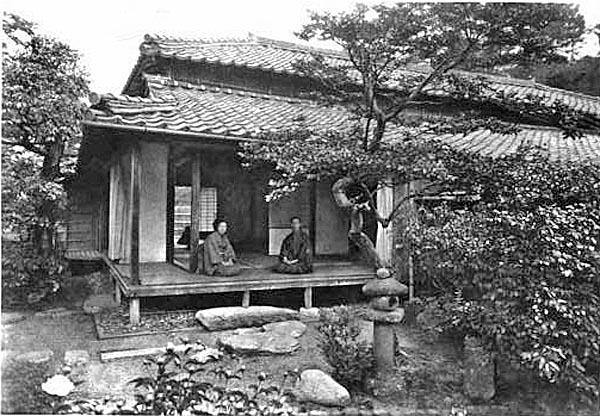
Matsue Hearn's House. The couple is Hearn and his wife, 1891
"I found it necessary to move to the northern quarter of the city,
into a very quiet street behind the mouldering castle.
My new home is a katchiu-yashiki, the ancient residence
of some samurai of high rank. It is shut off from the
street, or rather roadway, skirting the castle moat by a.
long, high wall coped with tiles. One ascends to the
gateway, which is almost as large as that of a temple
court, by a low broad flight of stone steps.
There exists a very pretty garden, or rather a series of garden spaces, which
surround the dwelling on three sides. Broad verandas
overlook these, and from a certain veranda angle I can
enjoy the sight of two gardens at once."
Photo from The Life and Letters of Lacadio Hearn, by Elizabeth Bisland, Houghton, Mifflin, Boston, 1906
Quotation from Glimpses of Unfamiliar Japan, p.248
Hearn's Garden.

"In Buddhism all existences are divided into Hijo,
things without desire, such as stones and trees; and Ufa,
things having desire, such as men and animals.
The folk-lore of my little domain relates both to the inanimate
and the animate. In natural order, the Hijo may
be considered first, beginning with a singular shrub near
the entrance of the yashiki, and close to the gate of the
first garden.
Within the front gateway of almost every old samurai
house, and usually near the entrance of the dwelling itself,
there is to be seen a small tree with large and peculiar
leaves. The name of this tree in Izumo is tegashiwa, and
there is one beside my door.
The shape of the
leaves of the tegashiwa somewhat resembles the shape of
a hand. Now, in old days, when the samurai retainer was
obliged to leave his home in order to accompany his
daimyo to Yedo, it was customary, just before his departure,
to set before him a baked tai [a local fish] served up on a
tegashiwa leaf.
After this farewell repast, the leaf upon
which the tai had been served was hung up above the
door as a charm to bring the departed knight safely back
again. This pretty superstition about the leaves of the
tegashiwa had its origin not only in their shape but in
their movement. Stirred by a wind they seemed to beckon, ó
not indeed after our Occidental manner, but in the way
that a Japanese signals to his friend to come, by gently waving
his hand up and down with the palm towards the ground."
Photo Panoramio
Text from Glimpses of Unfamiliar Japan, p.257
SHINKOKU, THE LAND OF THE GODS

The coast of Izumo-Shinkoku, south-west of Matsui
"Shinkoku is the sacred birth place of
Japan, - ďThe Land of
the Gods;Ē and of all Shinkoku the
most holy ground is Kitzuki..
Hither from the blue Plain of High
Heaven first came the
Earth-makers, Izanagi and Izanami, the
parents of gods and of men; somewhere upon the border of this land was
Izanami buried; and out of this land
into the black realm of the dead did
Izanagi follow after her, and seek in
vain to bring her back again.
And of all legends primeval concerning
the Underworld this story is one of the
weirdest,- more weird even than the
Assyrian legend of the Descent of Ish-
tar.
[Armed] with a letter of introduction from my dear friend Nishida Sentaro, I set out on my first journey to Kitzuki."
Photo and quotation from The Life and Letters of Lacadio Hearn, by Elizabeth Bisland, Houghton, Mifflin, Boston, 1906
FROM THE DIARY OF AN ENGLISH TEACHER.
MATSUE, September 2, 1890.
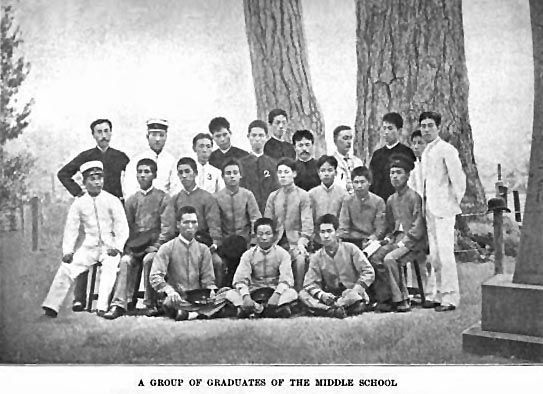
The Class of 1890 at Jinjo Chugakko. Hearn is the 4th from the right.
" I am under contract to serve as English teacher in
the Jinjo Chugakko, or Ordinary Middle School. The Jinjo Chugakko is an immense two-story
wooden building in European style, painted a dark
gray-blue. It has accommodations for nearly three
hundred day scholars. It is situated in one corner of
a great square of ground, bounded on two sides by
canals, and on the other two by very quiet streets.
This site is very near the ancient castle.
It is my first day at the schools. Nishida Sentaro,
the Japanese teacher of English, has taken me through
the buildings, introduced me to the Directors, and
to all my future colleagues.
Nishida leads the way to
the Kencho, or Prefectural office, situated in another
foreign-looking edifice across the street.
We enter it, ascend a wide stairway, and enter a
spacious room carpeted in European fashion. One person
is seated at a small round table, and about him are
standing half a dozen others : all are in full Japanese
costume, ceremonial costume, ó splendid silken ha-
kama, or Chinese trousers, silken robes, silken haori
or overdress, marked with their mon or family crests :
rich and dignified attire which makes me ashamed
of my commonplace Western garb. These are officials
of the Kencho, and teachers : the person seated is the
Governor. He rises to greet me, gives me the hand-
grasp of a giant.
Indeed the first impression of him is that of
a man of another race. While I am wondering
whether the old Japanese heroes were cast in a similar
mould, he signs to me to take a seat, and questions
my guide in a mellow basso. There is a charm
in the fluent depth of the voice pleasantly confirming
the idea suggested by the face.
The Governor suggests that I make visits to the celebrated
shrines of Kitzuki, Yaegaki, and Kumano,
and then asks : ó "
Does he know the tradition of the origin of the
clapping of hands before a Shinto shrine ? "
I reply in the negative ; and the Governor says
the tradition is given in a commentary upon the
Kojiki. "
It is in the thirty-second section of the fourteenth
volume, where it is written that Ya-he-Koto-
Shiro-nushi-no-Kami clapped his hands."
I thank the Governor for his kind suggestions and
his citation. After a brief silence I am graciously
dismissed with another genuine hand grasp ; and we
return to the school. "
Photo from The Life and Letters of Lacadio Hearn, by Elizabeth Bisland, Houghton, Mifflin, Boston, 1906
Letter from: Glimpses of Unfamiliar Japan, p.430
MUST SEE just for relief: An online blog of a Valentine's Day in today's Japanese Middle School (2008).
Akiba Kei (xxlithiumflower)
IZUMO TAISHA (Kitzuki)
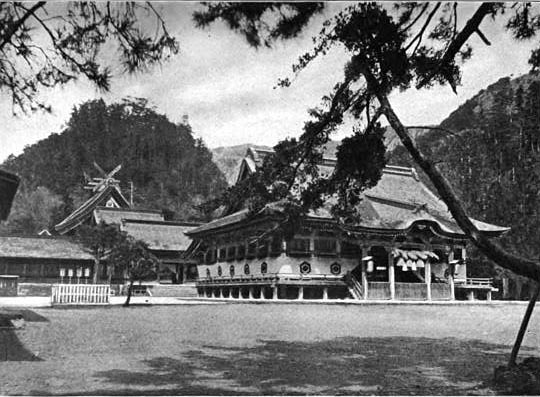
The Great Hall at Taisha, the oldest Shinto sanctuary in Japan and the birth-place of Shinto rites, mysteries and mythologies which would influence Hearn immensely: "Shinkoku, the Land where the Gods were born."
Hearn visited Taisha, (or as he calls it Kitzuki) during the school vacations in the Summer of 1891 which he spent in the nearby beach town of Kitzuki (now Izumo Taisha).
"Most memorable was his vision of one of the temple girls:
He writes in "Glimpses of Unfamiliar Japan":
"Always, through the memory of my first day at Kitzuki,
there will pass the beautiful white apparition of the Miko,
with her perfect passionless face, and strange, gracious,
soundless tread, as of a ghost. Her name signifies "the Pet," or "the Darling of the Gods," - Mi-ko.
Contrary to the custom at the other great Shinto
temples of Japan, such as Ise, the office of miko at Kitzuki
has always been hereditary. At the Kitzuki Oho-yashiro the maiden -priestesses are beautiful girls of between sixteen and nineteen years of age; and sometimes a favourite miko is allowed to continue
to serve the gods even after having been married.
Like the priestesses of Delphi, the miko was in ancient
times also a divineress,- a living oracle, uttering the secrets
of the future when possessed by the god whom she served.
At no temple does the miko now act as sibyl. But there still exists a class of divining-women, who claim to hold communication with
the dead, and to foretell the future, and who call themselves
miko, - practising their profession secretly; for it
has been prohibited by law.
In the various great Shinto shrines of the Empire the sacred
Miko-kagura dance is danced differently. In Kitzuki, it is most ancient
of all.
The origin of this dance is to be found in the Kojiki
legend of the dance of Ame-no-uzume-no-mikoto - she by
whose mirth and song the Sun-goddess was lured from
the cavern into which she had retired, and brought back to illuminate the world. And the suzu - the strange bronze
instrument with its cluster of bells which the miko uses
in her dance - still preserves the form of that bamboo-
spray to which Ame-no-uzume-no-mikoto fastened small
bells with grass, ere beginning her mirthful song."
Photo from The Life and Letters of Lacadio Hearn, by Elizabeth Bisland, Houghton, Mifflin, Boston, 1906
Text from: Lafcadio Hearn, "Glimpses of Unfamiliar Japan", Tauchnitz, Leipzig, 1910
HOKI 1890

By the Japanese Sea a few miles north of Matsui
THE FESTIVAL OF THE DEAD
"It is the fifteenth day of the seventh month, - and I
am in Hoki: The three days of the Bon. And on the
sixteenth day, after the shoryobune, the sea is the highway of the dead, who must pass back over its waters to their mysterious
home; and therefore upon that day is it called Hotoke-
umi, - the Buddha-Flood, - the Tide of the Returning
Ghosts. The Ships of Souls, have been launched. And ever upon the night of that sixteenth day, -
whether the sea be calm or tumultuous, - all its surface
shimmers with faint lights gliding out to the open, - the
dim fires of the dead; and there is heard a murmuring
of voices, like the murmur of a city far-off, - the indistinguishable
speech of souls.
The shoryobune
are much more elaborately and expensively constructed on this coast
than in some other parts of Japan; for though made of
straw only, woven over a skeleton framework, they are
charming models of junks, complete in every detail. Some
are between three and four feet long. On their white paper
sail is written the kaimyo or soul-name of the dead.
There is a small water-vessel on board, filled with fresh
water, and an incense-cup; and along the gunwales flutter
little paper banners bearing the mystic manji, which is
the Sanscrit svastika."
Photo Panoramio
Text from: Glimpses of Unfamiliar Japan, p.301
THE OKI ISLANDS 1890
Hearn joined a local merchant in 1890 on a visit to the Oki Islands, where no Westerner had been before. In local folklore the islands have an almost mythical connotation. They had been a place of exile for several former high-officials:
Already under the Nara period the islands were used as an exile for persons from the mainland. In 1198 Emperor Go-Toba (tenno) was sent to exile to Dogo where he stayed until his death in 1239. Between 1331 and 1333 tenno Go-Daigo was exiled to Nishino-shima
An old steamer takes them there. The mainland rececedes and eventually Nishinoshima Island comes in sight.

Amorgos and the Lesser Cycladic Islands in the Greek Archipelagos, RWFG, November 2005.
Hearn has no conscious memory of the islands of his birth in Greece. Yet his text preternaturally also describes the Greek archipelagos, which is the only seascape that resembles the Japanese Islands, especially in Winter:
"The luminous blankness circling us continued to
remain unflecked for less than an hour. Then out
of the horizon toward which we steamed, a small
gray vagueness began to grow. It lengthened fast,
and seemed a cloud. And a cloud it proved ; but
slowly, beneath it, blue filmy shapes began to define
against the whiteness, and sharpened into a chain of
mountains....
The first impression was almost uncanny. Rising sheer from the flood on
either hand, the tall green silent hills stretched away before us,
changing tint through the summer vapour, to form a fantastic vista of
blue cliffs and peaks and promontories. Above their pale bases of naked rock the mountains sloped up
beneath a sombre wildness of dwarf vegetation. There was absolutely no
sound, except the sound of the steamer's tiny engine--poum-poum, poum!
poum-poum, poum! like the faint tapping of a geisha's drum. ....
Yet these Oriental landscapes possess charms of colour extraordinary,
phantom-colour delicate, elfish, indescribable--created by the wonderful
atmosphere. Vapours enchant the distances, bathing peaks in bewitchments
of blue and grey of a hundred tones, transforming naked cliffs to
amethyst, stretching spectral gauzes across the topazine morning,
magnifying the splendour of noon by effacing the horizon, filling the
evening with smoke of gold, bronzing the waters, banding the sundown with ghostly purple and green of nacre."
From Glimpses of Unfamiliar Japan, p. 573
NEXT: JAPAN-KUMAMOTO-KYOTO-TOKYO












